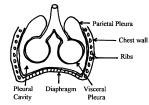- What is Pneumothorax
- Statistics on Pneumothorax
- Risk Factors for Pneumothorax
- Progression of Pneumothorax
- Symptoms of Pneumothorax
- Clinical Examination of Pneumothorax
- How is Pneumothorax Diagnosed?
- Prognosis of Pneumothorax
- How is Pneumothorax Treated?
- Pneumothorax References
What is Pneumothorax
Pneumothorax is a disease of the lungs.
The pleura are thin films of “connective tissue”, which line both the outer surface of the lungs, and the inside of the chest cavity. The relationship of the pleura to the lungs and chest can be imagined as if the pleura were a balloon blown up inside the chest, into which the lungs have been pushed.
Thus, there are in fact two layers of pleura between the outer surface of the lung and the chest wall. One is adherent to the lung, whereas the other layer follows the outline of the chest wall. The two layers press up against one another, and in the healthy chest, there is no air or significant fluid between them. In pneumothorax, air is present in this pleural ‘space’.
Statistics on Pneumothorax
There are no direct figures on the incidence of pneumothorax. However, it is a common problem, frequently as a complication of trauma (often undiagnosed), and it also commonly occurs as a spontaneous occrence, and in patients with previous lung disease.
Risk Factors for Pneumothorax
Pneumothorax in those over 40 years of age is commonly seen in the background of emphysema or chronic bronchitis. Occasionally, asthma, and other lung disease can cause a pneumothorax.
In younger patients, pneumothorax may occur spontaneously or due to chest trauma. Spontaneous pneumothorax commonly occurs in tall, thin young men (sex ratio: 6:1), due to rupture of small subpleural ‘blebs’. Trauma such as a rib fracture, or penetrating chest wall injury, may also cause pneumothorax.
Progression of Pneumothorax
Excluding that caused by chest trauma, pneumothorax arises due to rupture of alveoli, followed by rupture of the pleural lining of the lung. Provided this communication then seals itself off, air in the pleural space is gradually resorbed. If the communication between the pleural space and the airways remains open, a ‘bronchopleural fistula’ is created.
Rarely, the communication remains open, but the defect acts as a flap valve, allowing air into the pleural space on inspiration, but preventing it from escaping during expiration. Thus, air accumulates in the pleural space with each breath, compressing adjacent lung, and eventually compressing other structures in the chest, including the heart. This is called ‘tension pneumothorax’. Tension pneumothorax rarely occurs spontaneously.
How is Pneumothorax Diagnosed?
A chest x-ray is the test of choice: small pneumothorax (less than 20% of hemithorax) may be difficult to see on chest x-ray; and a film taken during expiration it may help visualise it.
Larger pneumothorax causes significant collapse of the lung, with shift of the trachea and mediastinum (heart and great vessels) away from the affected side.
Prognosis of Pneumothorax
Tension pneumothorax is a potentially life-threatening condition, due to restriction of venous return, and respiratroy and cardiac embarrassment. Otherwise, pneumothorax tends to slowly resolve, such that a pneumothorax causing 50% collapse of the lung will take 40 days to heal.
How is Pneumothorax Treated?
- Small pneumothorax may not require treatment, rather observation at 2-weekly intervals until the air has been reabsorbed.
- Larger, and tension, pneumothorax requires aspiration of air (needle passed between the ribs, into the pleural space), with insertion of an intercostal drainage tube soon after. This drainage tube ends with an underwater seal; thus, escaping air is seen as bubbles in the water, but air from the atmosphere can not go back in.
- Occasionally, the pneumothorax keeps bubbling after several days; this indicates the presence of bronchopleural fistula, and surgery may be needed. This involves either removal of the pleura, or adhesion of the two pleural layers to each other, by placing talc in the pleural space (talc pleurodesis).
- A tension pneumothorax should be treated with immediate decompression with a needle in the 2nd intercostal space (between the second and third rib at the front). This is then followed by a formal intercostal tube insertion as above.
Pneumothorax References
[1] Baumann MH. Treatment of spontaneous pneumothorax. Current Opinion in Pulmonary Medicine. 6(4):275-80, 2000 Jul.
[2] Cotran RS, Kumar V, Collins T. Robbins Pathological Basis of Disease Sixth Ed. WB Saunders Company 1999. p751
[3] Kumar P, Clark M. Clinical Medicine. Fourth Ed. WB Saunders, 1998. p825-26
[4] Talley NJ, O’Connor S. Clinical examination. Third Ed. MacClennan & Petty, 1996. p121
All content and media on the HealthEngine Blog is created and published online for informational purposes only. It is not intended to be a substitute for professional medical advice and should not be relied on as health or personal advice. Always seek the guidance of your doctor or other qualified health professional with any questions you may have regarding your health or a medical condition. Never disregard the advice of a medical professional, or delay in seeking it because of something you have read on this Website. If you think you may have a medical emergency, call your doctor, go to the nearest hospital emergency department, or call the emergency services immediately.








